– Feature Article – Top Fuel Cars: Rocket, Rubber Band, and More
– Q&A
Top Fuel Cars: Rocket, Rubber Band, and More
By Dave Noble
(The second in a series of articles on cars that ‘stretch the rules’)
My hobby is pinewood derby cars, especially cars that ‘stretch the rules’ just a bit. Even though my son is way beyond Cub Scout years, I still go to the pinewood derby each year to demonstrate my latest invention, and to put on a show for the kids and their parents. But before I tell you about my cars, let me share a little history so that you can see how I got the pinewood derby bug.
Background
During his first year as a cub scout my son Bret’s best friend was 3 years ahead of him. So when the pinewood derby came around he quickly found that his friend had all kinds of tips and tricks on how to make a pinewood car go fast. Little did he know that when he started to win, a curse would follow!
During his first pinewood derby race, Bret’s car was nearly as fast as the first place car. Everyone loves an underdog, and they were chanting, “Go Bret!”
The second year – when he built a car that was fast enough to win the derby and also District – no one was chanting, “Go Bret!” anymore (remember, they always chant for the underdog). During this second year at the district race there was an unlimited division. In that division were several rocket-powered cars. The cars were self-starting, with a switch on the front that fired the rocket motor automatically when the starting pin dropped. Sometimes a rocket motor would not fire. This was the ‘kiss of death’, since the winner was picked by average time. Bret and I took all of this in and wondered how the automatic firing device worked.
For his third year of racing Bret decided to build a ‘pretty’ car, even if it did not win. Winning was no longer important – he just wanted to be accepted. But to his dismay even the ‘pretty’ car won by a hair. The electronic finish line was really needed as the race was so close that even stop action video could not call the race.
The last year in Cub Scouts, Bret felt that he was an outsider, and no one wanted him to win. So he built a car that was faster than any car before, even beating his newest best friend. This car was fast enough that for the next seven years, when the car was entered into races against the winner of the derby, it was undefeated. Finally, someone built a three-wheeled car that beat Bret’s car by half a length. Since that time we have made changes to the car. Now outlaw wheels are mounted inside of the regulation wheels. The regulation wheels do not touch the track.
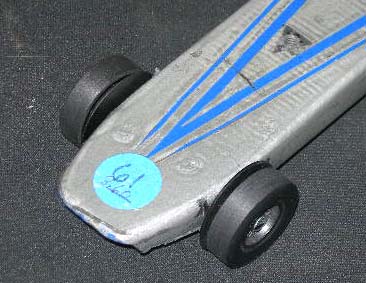
Bret moved on to Boy Scouts, and the first year the Eagle Scouts decided to sponsor a pinewood derby just for the Scouts in the troop. Every one knew about Bret’s reputation. Bret announced that he would not compete so that others would have a chance. When the winner was presented with a cash prize of fifty dollars, Bret exclaimed, “Dad I think I messed up on that one!”
A Rocket Car
Later that year we attended the movie “October Sky”. The movie is about a boy and his friends that built model rockets during the Sputnik era. After the movie I asked Bret this question: “How would you like to build a rocket powered pinewood derby car?” The answer was a resounding, “YES!”
So, we got out the video we had shot years before at the district race to try to figure out how the switches worked. We decided that we would need 3 switches. The first switch would turn the power on and off. The second switch, located in the front of the car, would trigger the firing mechanism when the starting pin dropped. The last switch on the top of the car was to arm the front switch (so that the rocket didn’t fire if switch one was turned on when the car was not against the starting pin). When Bret, his older scout friend, and I tried to figure out how to make this work, we were stumped. Suddenly Bret – who was only ten years-old at the time – announced, “I’ve got it!” Reluctantly, I gave the wires to him. About a minute later he correctly assembled the wires and switches so they worked.
The next step was to build the car and put all the wires and switches in place using the wiring pattern previously developed. I thought it would be neat to build a car that was only 5.0 ounces, but the final car weighed 6.5 ounces. We had no idea of how to test the car, but we wanted it to run on a normal pinewood track with no strings.
I remembered from my younger days building rocket boats that the rocket motor had to be mounted very straight in the back of the boat. We did not have a drill press, so instead we carefully used a variable speed drill to get the motor hole close to square.
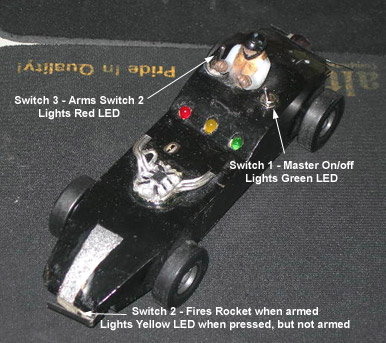
We built a test track that was only 15 feet long (that was all the wood I had). The test track ended in the grass on the front lawn. When we fired the car, it was so much faster than we expected that when it hit the grass it tumbled like an airliner during a crash. The good news was that it stayed on the short track until it hit the grass.
The next year we took the rocket car to the pinewood derby. We test fired it the day before, just to show the other leaders that it would really stay on the track. When we fired the car the first time in front of a crowd, they screamed at the sheer speed. The car covered the 32 foot track in 0.8 seconds.
Over the years we have improved the speed of the rocket car. Wheel-work, removing weight from the car, overcharging the battery, and last year we went to a nickel-metal-hydride battery (much lighter than an alkaline battery). The original 6.5 ounces is now down to 5.1 ounces. We plan to go with outlaw wheels this next year to get the weight to 4.9 ounces. One other note, the little man ‘driving’ the rocket car gets ejected out of the car when the parachute charge goes off. We wanted to put a chute on him but there was not enough room in the car to hold it.
Rubber Band Car
The first year, the rocket car ran solo. The second year, we decided to give the rocket car some competition, so we built a rubber band car to run against it.
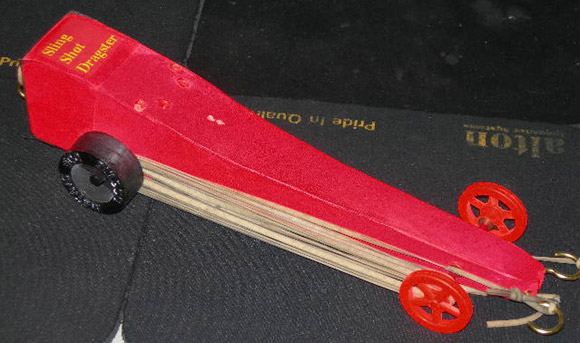
(The rubber band is stored around the wheels)
The rubber band car started as a retired CO2 car built by my daughter, Andrea. We painted it florescent red, and mounted two cup hooks on the front of the car. Then I went to the hobby store to find a long rubber band. I found one 7 feet long that I could stretch to over 50 feet. I did some calculations and found that when it was stretched to 35 feet it would pull the 1.2 pound car 32 feet in about 1 second. I wanted a close race but I wanted the rocket car to win.
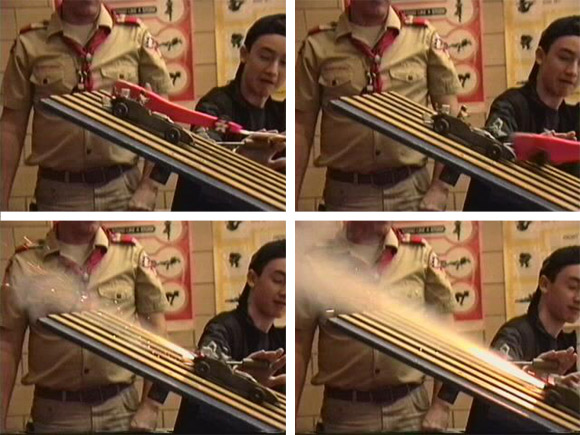
A Hobby
Time rolled on, and Bret graduated from high school. He was a very good student in school and announced that he was going to major in Electrical Engineering. I have never told my son anything to hold him back, but I will admit that when he said those words, I had the same proud feeling as when he stated he had figured out how the rocket car should be wired. Now that he is a 3-year engineering student, I can say, “Look what the pinewood derby did for my kid!”
With Bret in college I declared pinewood derby cars as a hobby, and decided it was time to build a rocket car that would be even faster than the original one. This one needed headlights and taillights. It also needed a better starting method, because rocket cars take about 0.25 seconds to fire the rocket motor. The car also needed to weigh less than 5.0 ounces, and it needed very fast wheels.
The new car needed a new wiring setup to power the two headlights and two taillights. I went back to the original wiring that Bret designed when he was ten years old, and copied it for the new car. When assembling the car I added a magnet onto the front of the car. The stake at our track is made of steel, so when it drops it gives the car a boost. I wired the car three times, tearing it apart again and again, because the car ended up too heavy. I had to get lighter wire. Finally after two weeks of working I had a finished car.
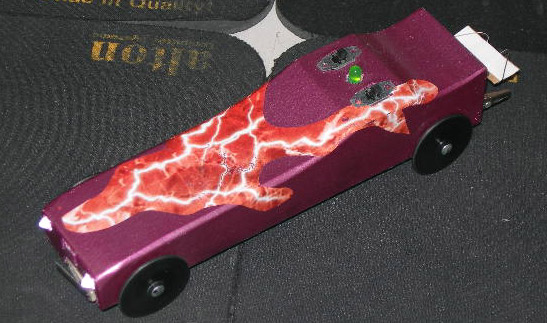
I have been invited back to the pack race each year, not to race in the derby, but to put on a show. The rocket car is of course part of the show. It is saved for last in order to keep everyone there till the end of the race (you know, some parents are always in a hurry and want to leave before the end of the race). This year we ran the new rocket car against the rubber band car. If you compared the earlier race with this one you will see a huge difference.
Here is a short video of the rocket car. In the video you will see a flash, and then see the rocket car hit the pillow at the end of the track. The headlights are so bright that the camera was blinded!
Video of New Rocket Car versus Rubber Band Car
Video & Spinner Corvettes
During intermission, I demonstrate other special cars to keep the scouts interested. One car that is popular is the Video Car. This is a 1/25 scale Corvette plastic body that mounts over a pinewood body. Inside of the wood I hollowed out a place for a nine-volt battery. I mounted a tiny color video camera in place of the driver.
So that the Video Corvette would have something to shoot while running, I built a White Corvette with spinner wheels. The spinner wheel Corvette has outlaw wheels mounted inside of smaller wheels with the rubber removed to make sure that they do not touch the ground. I applied black magic marker on the outer wheel surface to make it look like a black tire. The outlaw wheels support the car, and if mounted loosely the outer wheels will spin. I made sure that the spinner wheel Corvette was faster than the video car, so that the video car will always have something to take a picture of when the cars run together.
Both cars weigh exactly five ounces and both have magnets mounted in the front for quick starts – we wouldn’t want the Corvettes to lose to a normal pinewood derby car! I use the magnets to help the scouts know what magnets can do, and that the method is not legal in normal pinewood derby racing.
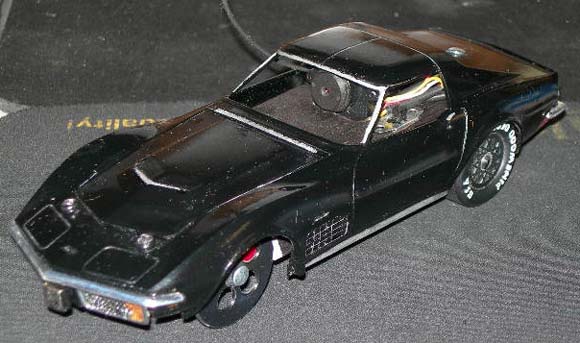
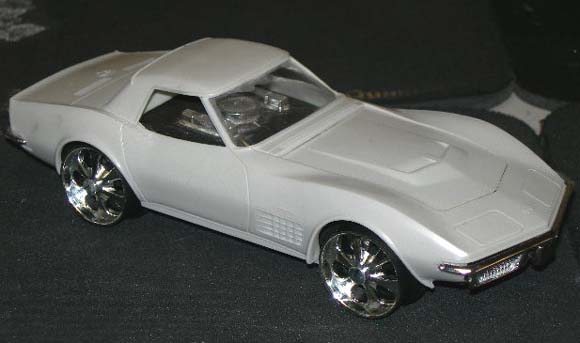
The Video car has a built in transmitter so that it can broadcast the view a pinewood driver would have of the track. This is shown on close circuit television while the video car runs down the track. I usually ask the scouts to imagine what it would be like to ride in a pinewood derby car. Once the scouts have the image in their minds we have them watch the car on TV. Then we run it again, because once is never enough!
Other Cars
Another car that is popular is the ‘No Passing Zone Car’. This is based on the car that my son won district with in 1994, but with some not so legal modifications. The main one is that I used coat hangers to build wire wings that stick into the competitions lanes. These are just high enough to clear the track and just long enough to stop anything from passing it. Just to assure a win the coat hanger also sticks out on front of the car about 3 inches. This actually gives the car a 3 inch head start at the starting line.
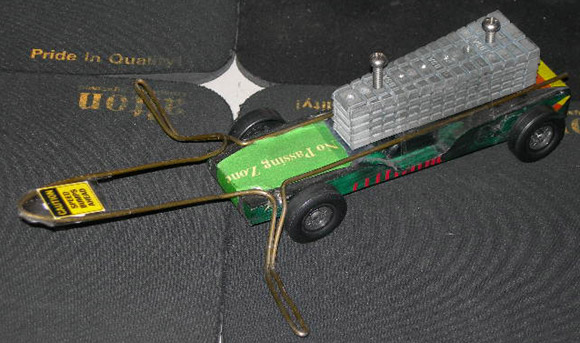
The scouts always want to have this car run against the rocket car. I do not attempt this because the rocket car can also go straight up. We discovered this in 2002 when my son’s hand came off the starting lever, and being spring loaded the starting pin came up under the rocket car just as it passed over the stake. Quite a spectacle!
Another car that is well-liked is the ‘Eveready Battery Car’. It features a large six volt lantern battery and has an LED that flashes on the back. A small nine volt battery powers the LED because the larger battery does not have enough voltage. The main feature of this car is the weight – 2.5 pounds. It is fast, and has a lot of momentum. We use a pillow to stop all the cars. The Rocket Car pops the pillow up; the Battery Car just pushes it out of the way. The scouts love to see the power of the heavy car.
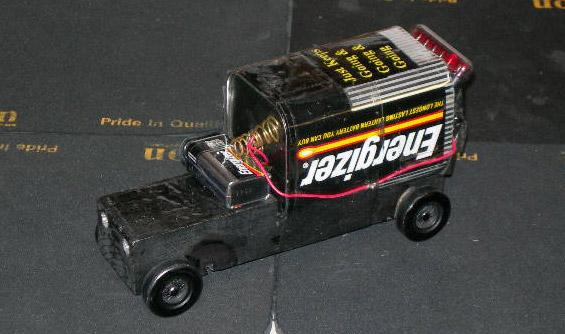
Conclusion
I have so much fun going back to the pinewood derby each year that I will keep doing it as long as the pack will invite me back. I try to develop something new for each year, using the new and sometimes crazy cars to illustrate the principles of inertia, friction, etc.
One reason I wrote this article is to encourage Dads everywhere to take more interest in the pinewood derby. More than anything else, this will help to develop your relationship with your son. It can also result in your son doing something great, because you made it your hobby too.
Q&A
What do you think of using very smooth plastic decals in the wheel well area to reduce friction?
Certainly you want the wheel hub to car body friction to be minimized. A plastic decal may help, as long as it creates a hard surface. If the decal flexes, then it actually could increase friction as the flexing would increase the surface area of contact (the hub essentially ‘sinks’ into the decal a little bit).
I don’t like the idea of running against bare wood (not smooth enough). Instead, I prefer to paint the side of the car, and then overcoat with a hard clear-coat. This leaves a hard, smooth finish for the hub to rub against. Add a bit of graphite, and you are ready to roll.
I noticed a series of three small, raised lines on the axles parallel to the head. Is it better to keep these lines on the axles (as a way to have less contact with the wheel bore if positioned correctly), or to remove them as would probably happen if one were to polish the axles? Also, do you know if these bumps will cause any concerns with the Pro-Axle Press I purchased?
I suggest not running on the ridges. So there are two choices:
- Remove the ridges. If you plan to use the Pro-Axle Press, you must remove the ridges before using the press. Otherwise, the ridges will eventually be imprinted into the press.
- Orient the axles such that the ridges are facing upwards. When mounted on the car, the bottom side of the axle contacts the wheel bore.
Where do you place feelers (whiskers) on the car?
For extended wheelbase cars, place the feelers between the axles. For standard wheelbase cars, place feelers in front of both axles. For more information on feelers, see “Feelers: Do they Work?” in Volume 6, Issue 7 – December 27, 2006.
Want Answers?
Do you have a pinewood derby-related question? If so, e-mail us your question.We answer all questions by e-mail, but not every question will appear in the Q&A section of the newsletter.
Back Issues
Are you a new subscriber, or have you missed some of the previous newsletters? Don’t miss out; all of the issues for Volume 5 through Volume 17 are posted on our web site.
Newsletter Contributions
We welcome your contributions. If you would like to contribute an article, a web site review, a speed tip, or a pinewood derby memory, please e-mail us.
Subscription Information
The Pinewood Derby Times is a free e-newsletter focused on pinewood derby racing. It is published biweekly from October through March.
If you haven’t already done so, please forward this issue to your pinewood derby friends. But please don’t subscribe your friends. Let them decide for themselves. Thanks.
If this newsletter was forwarded to you, why not subscribe to receive this newsletter. There is no cost, and your e-mail address is safe, as we never sell or share our distribution list.
To subscribe, send a blank e-mail to
pi*********************@*******st.com
You will receive a confirmation e-mail. Reply to the confirmation e-mail and you will start receiving the Pinewood Derby Times with the next issue.
Randy Davis, Editor, Pinewood Derby Times
E-Mail: in**@**************ty.com
(C)2018, Maximum Velocity, Inc. All rights reserved. Please do not reprint or place this newsletter on your web site without explicit permission. However, if you like this newsletter we grant permission, and encourage you to e-mail it to a friend.
Maximum Velocity disclaims any personal loss or liability caused by utilization of any information presented in this newsletter.
The Pinewood Derby Times is not specific to, and is not affiliated with the Boy Scouts of America, YMCA, Awana, or any other organization.
(R)Maximum Velocity is a registered trademark of Maximum Velocity, Inc.
(R)Pinewood Derby is a registered trademarks of the Boys Scouts of America.
(R)Awana is a registered trademark of Awana Clubs International.
All other names are trademarks of their respective owners.
